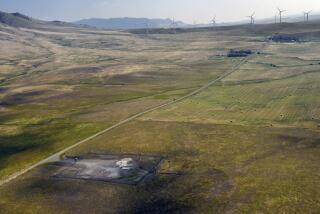Work Starts on 6 Missile Silos in Alaska
FT. GREELY, Alaska — Federal officials broke ground Saturday on six underground missile interceptor silos as part of the new missile defense system.
It will take more than two years to install the silos 115 feet beneath Ft. Greely for the Ground-based Midcourse Defense system.
“We need this for the defense of our country,” said Brig. Gen. John W. Holly, program director for the GMD Joint Program Office.
The Ft. Greely site, about 100 miles southeast of Fairbanks in the Alaska interior, will at first be used for testing. But the Pentagon hopes to have it ready as an emergency antimissile system by September 2004.
The Bush administration’s hurry to put a rudimentary system in place in Alaska by 2004 comes 19 years after President Reagan proposed a national defense against nuclear missile attack. Critics suggest presidential politics is the driving force behind the timetable.
The project’s purpose is to defend against the use of a limited number of nuclear missiles and is designed to eliminate mutual destruction as a strategy, said Sen. Ted Stevens (R-Alaska).
The missile test bed work will be done by Boeing Co. and its subcontractors, while Fluor Alaska will be general contractor.
“They’re just going to start digging holes,” GMD spokesman Lt. Col. Rick Lehner said.
When completed, the six silos, about 100 feet apart, each will have a 24-foot circumference and hold 70-foot-long missiles. There is room for 100 missile beds on the site. Fluor will install roads, fencing, support buildings and a power substation.
The work at Ft. Greely is expected to cost $325 million, officials said. The full system is estimated to cost $64 billion, including a sophisticated “X-band” radar station in the Aleutian Islands and a satellite system to detect launches.
Protesters waited at the main gate of Ft. Greely and at an area along the highway about two miles north of the entrance. No Nukes North, a Fairbanks-based anti-nuclear group, organized the protest, which began June 6 as a peace caravan across Alaska.
The protesters have been in the area since Thursday, voicing objections to the GMD as an offensive--rather than defensive--program, its expense and the nuclear dangers.
More to Read
Sign up for Essential California
The most important California stories and recommendations in your inbox every morning.
You may occasionally receive promotional content from the Los Angeles Times.










